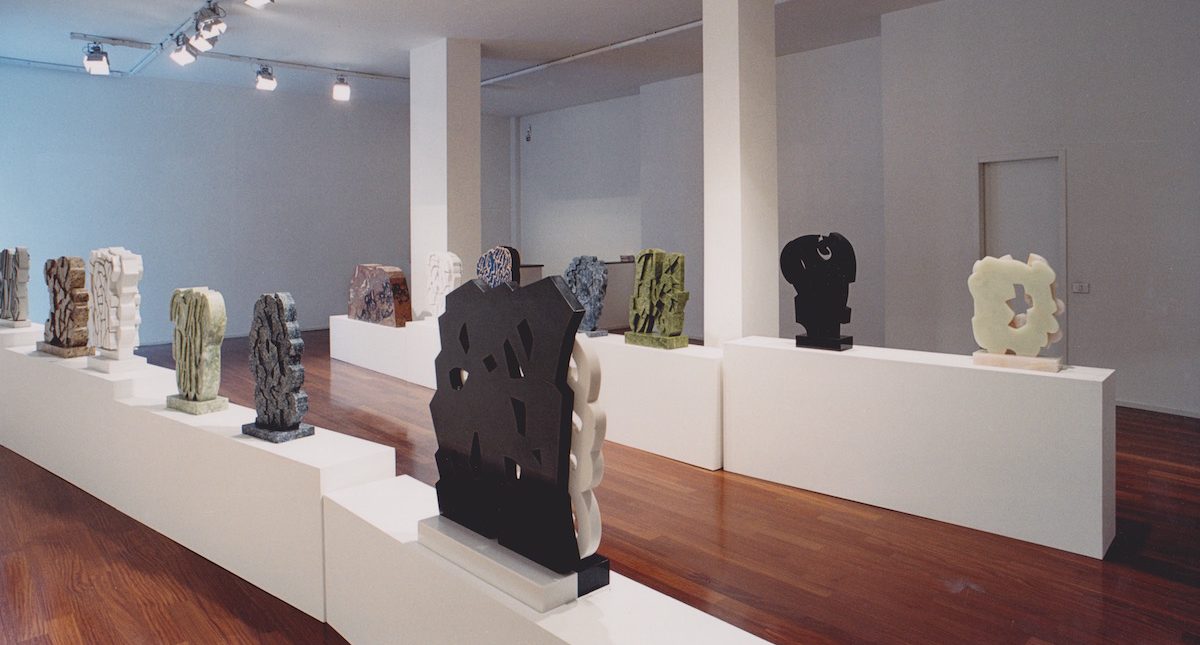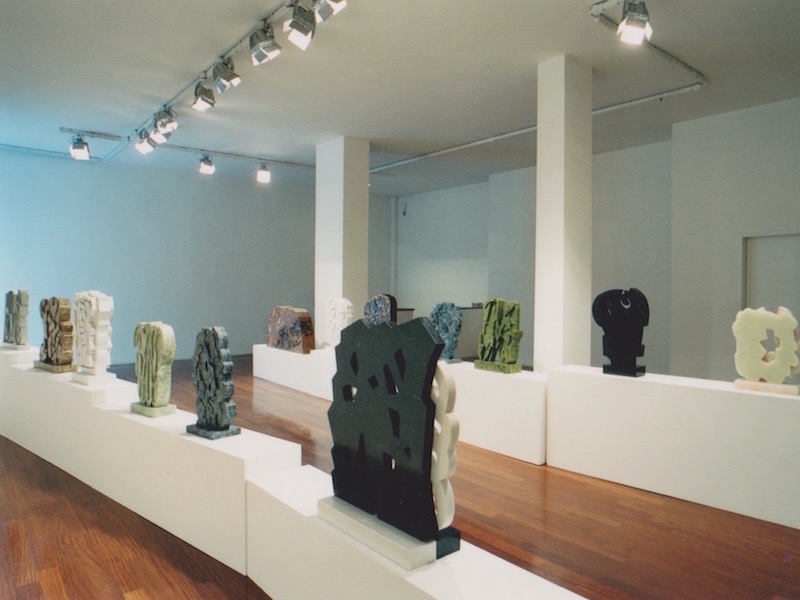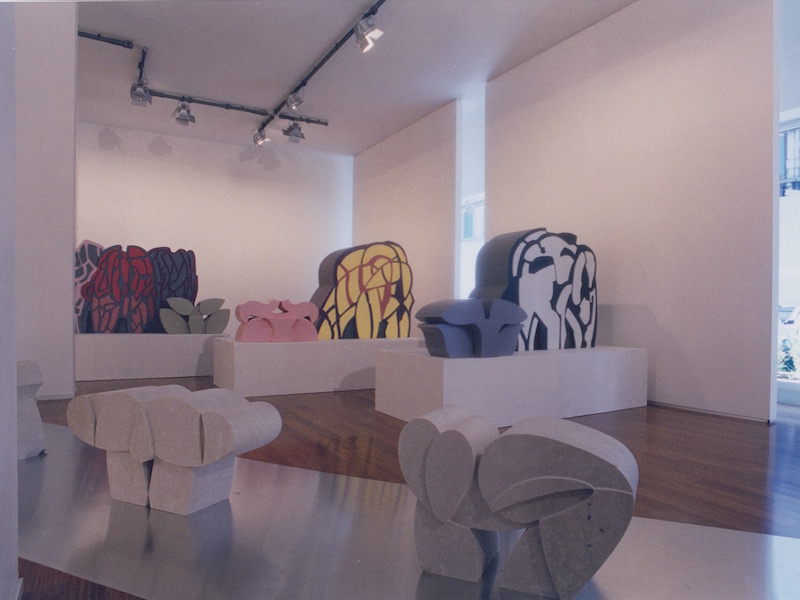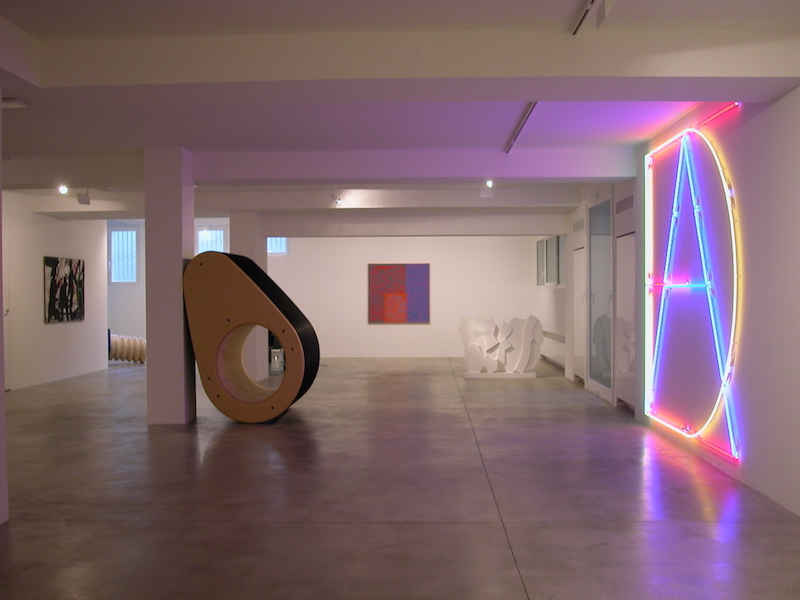PIETRO CONSAGRA
PIETRO CONSAGRA

Biography
Born in Mazara del Vallo in 1920 Pietro Consagra passed away in Milan in 2005. He attended the schools in Palermo and moved to Rome in 1944 where kept studying at the Academy of Fine Arts even if retired shortly before graduation, considering the institution excessively conservative. On 15 March, 1947, with Carla Accardi, Ugo Attardi, Piero Dorazio, Mino Guerrini, Achille Perilli, Antonio Sanfilippo and Giulio Turcato, he signed the manifesto of the “Gruppo Forma”, published on the single issue of “Forma 1” magazine. Declaring themselves as “formalists and Marxists”, the young artists of “Forma 1” wanted to affirm pure form as their aesthetic value and the sole purpose of art. Starting from 1948 his idea of sculpture turned to dematerialization, to bronze little thick compositions that refused a plurality of points of view and conceiving an exclusively frontal fruition. Reached the front the presence of signs broke and began to be articulated in superpositions with voids as parts of the work. In 1964, when Pop Art was presented at the Venice Biennale, Consagra approached color and experimented with painting on nitre and aniline enamel, as a reaction to the new tendencies in art marking a step forward in his work. In the 90s he approached new projects, always consistent with the fundamental elements of his poetics: the frontal point of view applied to diverse kind of works, the dematerialization of sculpture, the relationship between sculpture and architecture.
In the 90s some of his great sculptures were arranged in the streets of Milan, Rome and in the park of the Palazzo d’Orléans in Palermo. Until the early 2000s, he worked on important exhibition projects. Besides the numerous participations in national and international exhibitions with the “Gruppo Forma”, many were the solo exhibitions held in institutions: MART, Rovereto (2018), Italian Institute of Culture, London (2017), Museo di Castelvecchio, Verona (2007, 1977), European Parliament, Strasbourg (2003), Center of Art, Cairo (2001), Museion, Bolzano and Galerie der Stadt, Stuttgart (2000), National Gallery of Modern Art, Rome (2000, 1993, 1989), Palazzo d’Orléans, Palermo (1998 ), Insitut Mathildenhöhe, Darmstadt (1997), Academy of Fine Arts of Brera, Milan (1996), Hermitage, St. Petersburg (1991), Palazzo dell’Arengo, Rimini and Museo d’Arte Grafica, Gibellina (1981), Chiostro di San Nicolò, Spoleto (1979), Salone Annunciata, Milan (1976), Palazzo dei Normanni, Palermo (1973), Museum Boymans van-Beuningen, Rotterdam (1967), Palais des Beaux-Arts, Brussels (1958). Among the numerous group exhibitions in institutions: Palazzo Strozzi, Florence (2018), Museo del Novecento, Milan (2017), The Solomon R. Guggenheim, New York (2012), National Gallery of Modern Art, Rome (2011), Peggy Guggenheim, Venice (2008), Centre Georges Pompidou, Paris (2007), Musée des Beaux-Arts, Montréal (2006), La Triennale, Milan (2004), MAMAC, Liege (2003), MART, Rovereto (2002), Museum of Argenti, Florence (2001), Jízdárna Prazského Hradu, Prague (1998), Palazzo Ducale, Venice (1995),
Museo della Permanente, Milan (1994), Institut Mathildenhöhe, Darmstadt (1988), Museo Civico, Gibellina (1986), Museo Nacional de Bellas Artes, Buenos Aires (1971), Musée d’Art Moderne, Paris (1968), The National Museum of Modern Art, Tokyo (1967), Kunsthalle, Düsseldorf (1961), Musée Rodin, Paris (1960), Museu de Arte Moderna, Sao Paulo (1959), The Museum of Fine Arts, Houston (1958), The Brooklyn Museum, New York (1957), Tate Gallery, London (1953), The Art Institute of Chicago (1952), National Gallery of Modern Art, Rome (1951), Palais des Beaux-Arts, Paris (1948). Consagra also took part several times in the Venice Biennale (1993, 1982, 1972, 1968, 1964, 1962, 1960, 1956, 1954, 1952, 1950), Rome Quadriennale (2005, 1999, 1992, 1986, 1973, 1965, 1955 ), Documenta, Kassel (1964, 1959) and Sao Paulo Biennial (1955). His collaboration with Galleria Fumagalli began in 1996 when, on the occasion of the exhibition hosted at the Brera Academy of Fine Arts in Milan, the gallery promoted the publication of the volume “Scultura e architettura” curated by Giovanni Maria Accame and Gabriella di Milia. In 1997 the artist’s first personal exhibition “Banche e Panche” was presented at the gallery, accompanied by the catalog “Consagra e la frontalità”; in the same year an anastatic reprint of the theoretical booklet “La città frontale” written by Pietro Consagra in 1969 was republished. In 2002 the artist exhibited again at Galleria Fumagalli proposing a series of sculptures made with polychrome marbles and on that occasion was also presented the volume “Pietro Consagra. Pietre Consagra” curated by Ada Masoero.
Biography
Born in Mazara del Vallo in 1920 Pietro Consagra passed away in Milan in 2005. He attended the schools in Palermo and moved to Rome in 1944 where kept studying at the Academy of Fine Arts even if retired shortly before graduation, considering the institution excessively conservative. On 15 March, 1947, with Carla Accardi, Ugo Attardi, Piero Dorazio, Mino Guerrini, Achille Perilli, Antonio Sanfilippo and Giulio Turcato, he signed the manifesto of the “Gruppo Forma”, published on the single issue of “Forma 1” magazine. Declaring themselves as “formalists and Marxists”, the young artists of “Forma 1” wanted to affirm pure form as their aesthetic value and the sole purpose of art. Starting from 1948 his idea of sculpture turned to dematerialization, to bronze little thick compositions that refused a plurality of points of view and conceiving an exclusively frontal fruition. Reached the front the presence of signs broke and began to be articulated in superpositions with voids as parts of the work. In 1964, when Pop Art was presented at the Venice Biennale, Consagra approached color and experimented with painting on nitre and aniline enamel, as a reaction to the new tendencies in art marking a step forward in his work. In the 90s he approached new projects, always consistent with the fundamental elements of his poetics: the frontal point of view applied to diverse kind of works, the dematerialization of sculpture, the relationship between sculpture and architecture.
In the 90s some of his great sculptures were arranged in the streets of Milan, Rome and in the park of the Palazzo d’Orléans in Palermo. Until the early 2000s, he worked on important exhibition projects. Besides the numerous participations in national and international exhibitions with the “Gruppo Forma”, many were the solo exhibitions held in institutions: MART, Rovereto (2018), Italian Institute of Culture, London (2017), Museo di Castelvecchio, Verona (2007, 1977), European Parliament, Strasbourg (2003), Center of Art, Cairo (2001), Museion, Bolzano and Galerie der Stadt, Stuttgart (2000), National Gallery of Modern Art, Rome (2000, 1993, 1989), Palazzo d’Orléans, Palermo (1998 ), Insitut Mathildenhöhe, Darmstadt (1997), Academy of Fine Arts of Brera, Milan (1996), Hermitage, St. Petersburg (1991), Palazzo dell’Arengo, Rimini and Museo d’Arte Grafica, Gibellina (1981), Chiostro di San Nicolò, Spoleto (1979), Salone Annunciata, Milan (1976), Palazzo dei Normanni, Palermo (1973), Museum Boymans van-Beuningen, Rotterdam (1967), Palais des Beaux-Arts, Brussels (1958). Among the numerous group exhibitions in institutions: Palazzo Strozzi, Florence (2018), Museo del Novecento, Milan (2017), The Solomon R. Guggenheim, New York (2012), National Gallery of Modern Art, Rome (2011), Peggy Guggenheim, Venice (2008), Centre Georges Pompidou, Paris (2007), Musée des Beaux-Arts, Montréal (2006), La Triennale, Milan (2004), MAMAC, Liege (2003), MART, Rovereto (2002), Museum of Argenti, Florence (2001), Jízdárna Prazského Hradu, Prague (1998), Palazzo Ducale, Venice (1995),
Museo della Permanente, Milan (1994), Institut Mathildenhöhe, Darmstadt (1988), Museo Civico, Gibellina (1986), Museo Nacional de Bellas Artes, Buenos Aires (1971), Musée d’Art Moderne, Paris (1968), The National Museum of Modern Art, Tokyo (1967), Kunsthalle, Düsseldorf (1961), Musée Rodin, Paris (1960), Museu de Arte Moderna, Sao Paulo (1959), The Museum of Fine Arts, Houston (1958), The Brooklyn Museum, New York (1957), Tate Gallery, London (1953), The Art Institute of Chicago (1952), National Gallery of Modern Art, Rome (1951), Palais des Beaux-Arts, Paris (1948). Consagra also took part several times in the Venice Biennale (1993, 1982, 1972, 1968, 1964, 1962, 1960, 1956, 1954, 1952, 1950), Rome Quadriennale (2005, 1999, 1992, 1986, 1973, 1965, 1955 ), Documenta, Kassel (1964, 1959) and Sao Paulo Biennial (1955). His collaboration with Galleria Fumagalli began in 1996 when, on the occasion of the exhibition hosted at the Brera Academy of Fine Arts in Milan, the gallery promoted the publication of the volume “Scultura e architettura” curated by Giovanni Maria Accame and Gabriella di Milia. In 1997 the artist’s first personal exhibition “Banche e Panche” was presented at the gallery, accompanied by the catalog “Consagra e la frontalità”; in the same year an anastatic reprint of the theoretical booklet “La città frontale” written by Pietro Consagra in 1969 was republished. In 2002 the artist exhibited again at Galleria Fumagalli proposing a series of sculptures made with polychrome marbles and on that occasion was also presented the volume “Pietro Consagra. Pietre Consagra” curated by Ada Masoero.
Works
Works
Works
SOLO EXHIBITIONS
GROUP EXHIBITIONS
Exhibitions
SOLO EXHIBITIONS
GROUP EXHIBITIONS






















Steht ein Spieler in der OASIS-Sperrdatei, darf er in keinem GGL-lizenzierten Casino in Deutschland mehr
spielen. Casinos ohne deutsche GGL Lizenz lassen sich bequem über den Browser spielen. Auch wenn deutsche Spieler in Casinos mit Lizenzen aus Curaçao oder Anjouan spielen, bedeutet dies dennoch
eine gültige Regulierung. Online Casino ohne deutsche Regeln eröffnet Spielern die Möglichkeit, abseits der
gewohnten Vorschriften und Beschränkungen ein individuelles und spannendes Glücksspielerlebnis
zu erleben. Ein Online Casino ohne deutsche Regeln ermöglicht Spielern eine alternative
Glücksspielerfahrung mit abweichenden Regelungen und vielfältigen Spielmöglichkeiten. Ein Casino ohne Konto bietet eine bequeme und anonyme Möglichkeit, Glücksspiele online zu genießen.
Genau dieser Punkt ist der Grund, weshalb die Onlineanbieter hierzulande über nun fast zwei Jahrzehnte bekämpft wurden. Wer mit einer deutsche Zulassung hausieren gehen kann, scheint im Vorteil.
Ein Casino ohne deutsche Lizenz mag auf den ersten Blick einen Wettbewerbsnachteil haben. Du musst
den Spielanbieter nur anwählen und kannst sofort
loslegen. Hinzu kommen nicht selten Gewinnspiele, Turniere und Cashbacks.
References:
https://online-spielhallen.de/beste-online-casino-spiele-2025-top-tipps/
Die rechteckigen Pokerchips im 10er-Pack von Slowplay überzeugen uns,
weil sie sich deutlich von den anderen Pokerchips unterscheiden.
Die Bullets Playing Cards Pokerchips Tony werden in einem Set aus
25 Chips mit einem aufgedruckten Wert von 100 geliefert.
Diese bunten, runden Münzen stehen für unterschiedliche Geldwerte und tragen zu einem authentischen Spielgefühl bei.
Für ein gleichmäßiges Spielerlebnis und ein gepflegtes Poker-Zubehör-Set ist die
regelmäßige Wartung Ihrer Pokerchips unerlässlich. Die Chips werden nicht nur optisch
aufgewertet, sondern auch geschmeidiger und widerstandsfähiger
gegen Verschmutzungen. Um die Pokerchips
effizient zu pflegen, sollten Sie etwa 20ml Öl für 500 Chips einplanen.
Das Farbwertsystem stellt sicher, dass Spieler schnell einschätzen können, wie viel Geld im
Spiel ist. Beispielsweise stehen weiße Chips üblicherweise für
1 $, rote Chips für 5 $, grüne Chips für 25 $, schwarze Chips für
100 $ und violette Chips für 500 $. Das Gewinnerset war nicht das schönste –
es war das einzige, das die Überwachung lesen konnte schnellsten mit Stapeln,
die halb von Händen verdeckt sind. Das Gesetz ist Unterscheidbarkeit, Rückverfolgbarkeit und überprüfbare Kontrolle.
References:
https://online-spielhallen.de/sol-casino-auszahlung-ihr-umfassender-leitfaden-fur-reibungslose-gewinnauszahlungen/
Sie haben die Wahl unter den unterschiedlichsten Themen, es gibt ganz einfach gehaltene Retroslots, die nur drei Walzen besitzen. Sie finden die beliebtesten Spiele, wie zum Beispiel die beliebten Bücherslots Book
of Ra und Book of Dead, aber auch Früchteslots, wie Sizzling Hot.
Das liegt daran, dass das Casino die deutschen Gesetze einhält, die dazu entwickelt
wurden, um die Spielsucht einzudämmen. Dass der Betreiber so viel Erfahrung hat, zeigt sich nicht nur in der Spieleauswahl, sondern auch in vielen weiteren Punkten. Zu den Wichtigsten gehört,
dass keine Tischspiele und Live Games angeboten werden dürfen.
Besuchen Sie auf jeden Fall unsere Webseite für Spielothek mit Mindesteinzahlung, um sich zu informieren.
Das bedeutet, dass Sie keine Tischspiele wie Poker, Baccarat,
Blackjack oder Roulette finden werden. Derzeit konzentriert
sich CrazyBuzzer auf virtuelle Spielautomaten, was aufgrund seiner Betriebslizenz auch Sinn macht.
Es gibt genügend Kategorien, damit Sie Ihre Lieblingsspiele auswählen können.
References:
https://online-spielhallen.de/ihr-weg-zum-n1-casino-login-eine-umfassende-anleitung/
Every login at King Billy Casino brings you back into a
world built for your enjoyment, security, and success. Every security event is meticulously logged with detailed
information, ensuring complete transparency and giving you the data needed to understand and address any potential issues.
King Billy Casino employs a vigilant and continuous monitoring system for all login activities, serving as your
proactive shield against suspicious behavior and potential security threats.
Your favorite games, betting limits, and even your last
played slots are right there waiting for you.
King Billy Casino offers responsible gaming tools to help players set deposit limits,
take a break or self-exclude if needed. Casino gaming is meant to
be entertainment, responsible play is key to a sustainable gambling experience.
References:
https://blackcoin.co/level-up-casino-login-guide/
This really is just a way to have a bit more fun at the
tables and to make your playing cash last longer. The only way a progression really works in the long run is
if you dedicate a low starting stake and then stop playing
after an X number of losses in a row (that you are comfortable with).
Table games are automated games that work based on RNG software, just
like slots. This means you can’t withdraw unless you clear the bonus
of any wagering requirements, which is why it’s
usually a smart way to skip the bonus if the WRs are over 40x.
You’ll want to check out Megaways, Hold & Win machines,
and slots that allow you to buy the bonus. Some pokies can be medium-high
or low-medium, which indicates a combination of those volatility levels.
It’s the opposite of the house edge (the casino’s advantage), and is calculated over millions of
spins.
References:
https://blackcoin.co/monte-casino-overview/
You will be able to do this upon subsequent deposits. You do not need to
worry that upon registration there is no opportunity
to activate Golden Crown Casino bonus codes.
This is a great way to have a good time with the Golden Crown Casino.
Here you can play European, American roulette, many types of blackjack, baccarat, video poker and many other projects.
This is a modern format of gambling entertainment based
on a random number generator.
Should any technical issues arise, or should any questions
pertaining to bonuses and payments be required, assistance will
always be available. It is evident that there are ample opportunities to augment one’s balance and prolong gameplay without the necessity of
expending a significant amount of personal funds. A further significant benefit is the broad selection of games available.
There is no requirement to travel to a physical venue or to wait for doors to open, as the casino is perpetually
accessible online.
Using Golden Crown Casino Online login, you can access your account,
make your first deposits, collect bonuses and play for real money.
The Golden Crown casino login Australia process is designed for simplicity and reliability, giving players secure access to their
accounts within seconds. The platform ensures a smooth experience for every player, whether
you’re logging in from a desktop or mobile device. Built for convenience, it
ensures smooth navigation across desktop and mobile devices, allowing members to
explore their favourite games, promotions,
and bonuses with ease. Casino.guru is an independent source of information about online casinos and online casino games, not controlled by any gambling
operator.
References:
https://blackcoin.co/mr-o-the-best-crypto-casino/
casino online paypal
References:
https://www.smilecarexport.com/bbs/board.php?bo_table=free&wr_id=38891
online casino with paypal
References:
https://rhea-recrutement.com/employer/top-online-casinos-us-org-reviews-scam-or-legit-check/
gamble online with paypal
References:
https://jobstak.jp/companies/paypal-gambling-sites-where-its-accepted/
australian online casinos that accept paypal
References:
https://asteroidsathome.net/boinc/view_profile.php?userid=1067710
online casino real money paypal
References:
https://jobsathealthcare.com/employer/top-10-list-of-casino-sites-our-expert-picks-for-2025/
usa casino online paypal
References:
https://icmimarlikdergisi.com/kariyer/companies/find-top-real-money-online-casino-sites-2025/
Beste xxx platforms leveren veilig hoogwaardige
expliciete inhoud. Kies voor veilige porno hubs voor een discrete ervaring.
my homepage – ebony porn